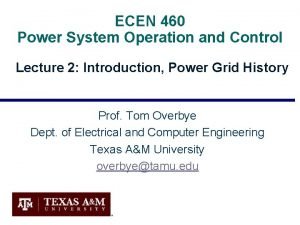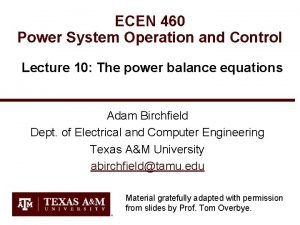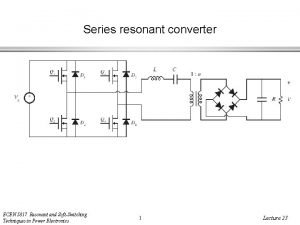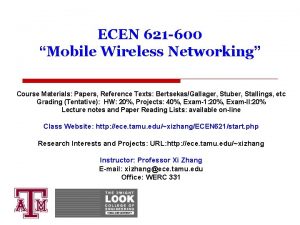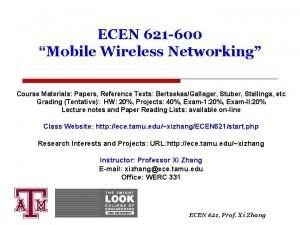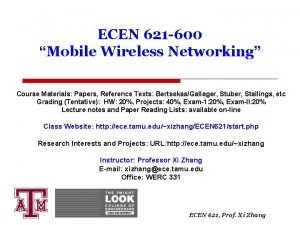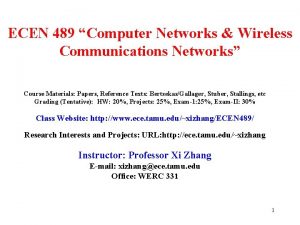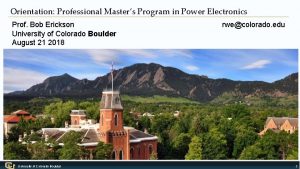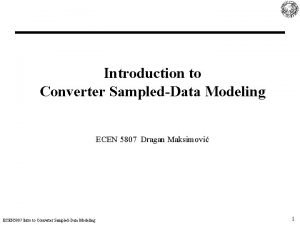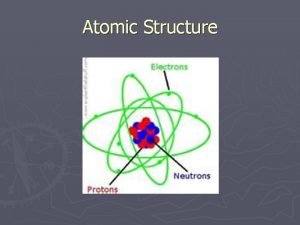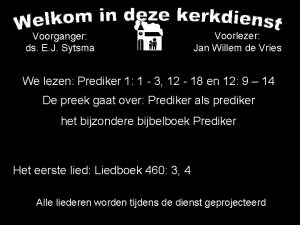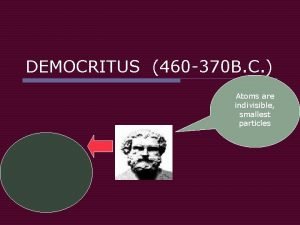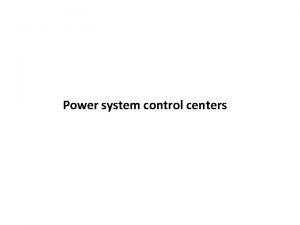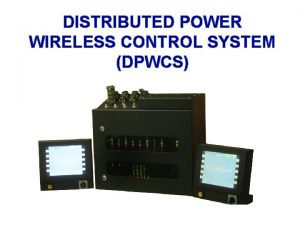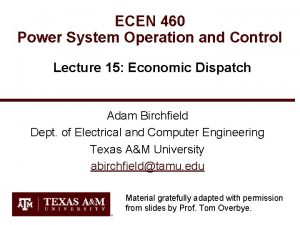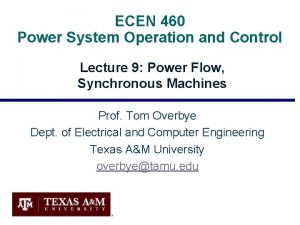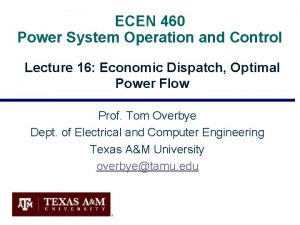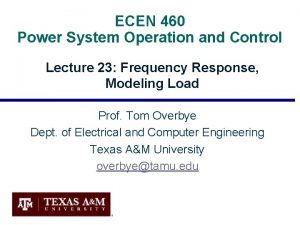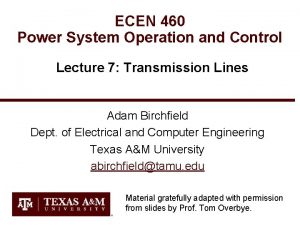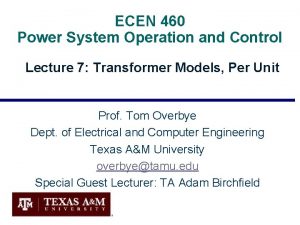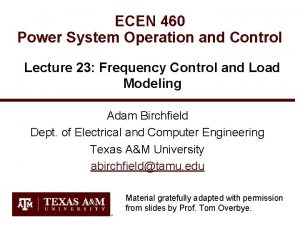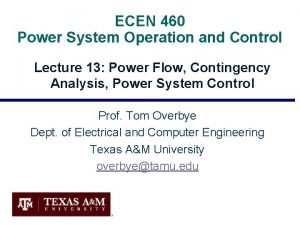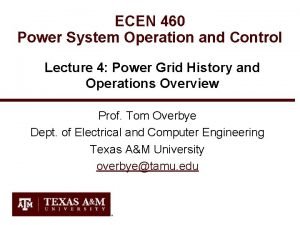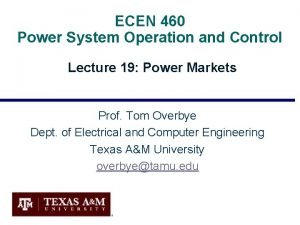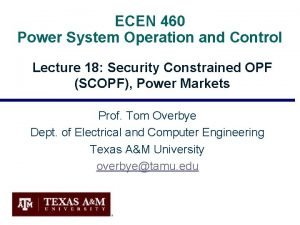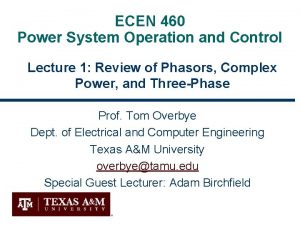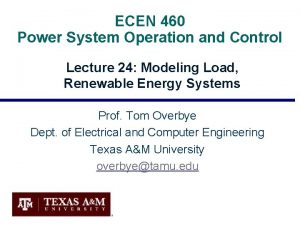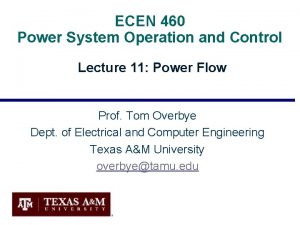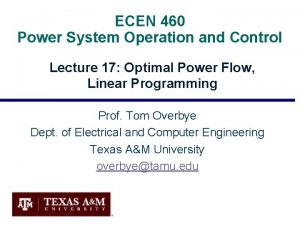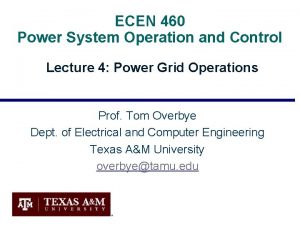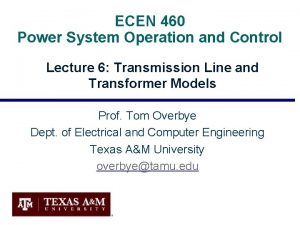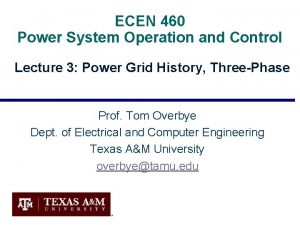ECEN 460 Power System Operation and Control Lecture









































- Slides: 41

ECEN 460 Power System Operation and Control Lecture 10: Synchronous Machine Modeling Prof. Tom Overbye Dept. of Electrical and Computer Engineering Texas A&M University overbye@tamu. edu

Announcements • After the test read Chapter 6. 7 to 6. 11 • HW 4 is 6. 9, 6. 12, 6. 18, 6. 25 – It should be done before the first exam, but need not be turned in. • Lowest two homework scores will be dropped • First exam is Thursday Oct 5 in class; one of my old exams is posted for reference; closed book, closed notes, one 8. 5 by 11 inch note sheet allowed; calculators allowed – Exam covers up to Sept 28 lecture, except not the synchronous machine material 1

Rotation Speed and Two Main Types of Synchronous Machines • Machines may have multiple pole pairs to spin at speeds slower than the electrical frequency • Round Rotor – Air-gap is constant, used with higher speed machines • Salient Rotor (often called Salient Pole) – – Air-gap varies circumferentially Used with many pole, slower machines such as hydro 2

Synchronous Machine Rotors • Rotors are essentially electromagnets Two pole (P) round rotor Image Source: Dr. Gleb Tcheslavski, ee. lamar. edu/gleb/teaching. htm Six pole salient rotor 3

Synchronous Machine Rotors High pole salient rotor Shaft Part of exciter, which is used to control the field current Image Source: Dr. Gleb Tcheslavski, ee. lamar. edu/gleb/teaching. htm 4

Synchronous Machine Stators Image Source: Book, Beginning of Chapter 8 Photo 5

Synchronous Generators Image Source: Book, Beginning of Chapter 11 Photo 6

Brief Coverage of Magnetics Ampere’s circuital law: 7

Magnetic Flux Density • Magnetic fields are usually measured in terms of flux density 8

Magnetic Flux 9

Flux linkages and Faraday’s law 10

Inductance For a linear magnetic system, that is one where B =m. H we can define the inductance, L, to be the constant relating the current and the flux linkage l =Li where L has units of Henrys (H) 11

Inductance Example • Calculate the inductance of an N turn coil wound tightly on a torodial iron core that has a radius of R and a cross-sectional area of A. Assume – – all flux is within the coil all flux links each turn 12

Inductance Example, cont’d Let N=100, A= 0. 0006 m 2, R=0. 03 m, mr=1000; then L is 0. 04 H; 13

Creating a Voltage in an Open. Circuited Generator • With zero stator current, the only flux is due to the field current • When the generator is at standstill, the flux linking each coil depends on its angle relative to the rotor’s position (and hence the field winding) – The three phases are physically shifted by 120 degrees from each other The maximum flux depends on the field current 14

Creating a Voltage in an Open. Circuited Generator • No voltage is generated at standstill • Now assume the rotor is spinning at a uniform rate, w = 2 pf, so 15

Creating a Voltage in an Open. Circuited Generator • Then by Faraday’s law a voltage is induced 16

Creating a Voltage in an Open. Circuited Generator • For a linear magnetic circuit we can also write this as proportional to field current The negative sign could be removed with a change in the assumed polarity 17

Magnetic Saturation and Hysteresis • A linear magnetic circuit assumes the flux density B is always proportional to current, but real magnetic materials saturate Magnetization curves of 9 ferromagnetic materials, showing saturation. 1. Sheet steel, 2. Silicon steel, 3. Cast steel, 4. Tungsten steel, 5. Magnet steel, 6. Cast iron, 7. Nickel, 8. Cobalt, 9. Magnetite; highest saturation materials can get to around 2. 2 or 2. 3 T H is proportional to current Image Source: en. wikipedia. org/wiki/Saturation_(magnetic) 18

Magnetic Saturation and Hysteresis • Magnetic materials also exhibit hysteresis, so there is some residual magnetism when the current goes to zero; design goal is to reduce the area enclosed by the hysteresis loop To minimize the amount of magnetic material, and hence cost and weight, electric machines are designed to operate close to saturation Image source: www. nde-ed. org/Education. Resources/Community. College/Mag. Particle/Graphics/BHCurve. gif 19

Frequency Impacts • Assuming no saturation, the generated voltage is then proportional to frequency • To create the same voltage with less flux, we just need to increase the frequency; this is why aircraft operate at a higher frequency (e. g. , 400 Hz) • When controlling motors with variable frequency, common control is to use constant volt/Hz, preventing saturation 20

Synchronous Machines with Output Current • When operating with an output current, the terminal voltage is not equal to the internally generated voltage • This is due to several factors – – Resistance in the stator windings Self-inductance in the stator windings Distortion of the air-gap magnetic field due to the stator current; that is, the stator current induces a magnetic field Salient pole characteristics of the machine • The stator reactance is called the synchronous reactance, XS, and is sometimes broken into two parts Xl is due to the winding self inductance 21

A Synchronous Machine Model • This gives us the following per phase model, which can be helpful in considering how the steady-state real and reactive output of the machine changes with changes in the field current • This model is not particularly good for saturation and understanding the generator’s dynamic response, something we’ll revisit in Chapter 11 22

Synchronous Machine Testing to Determine Its Parameters • These synchronous machine parameters can be determined from two tests (which we’ll do in Lab 4) – – Open-circuit test: measure the machine’s response when there is no load, and the field current is gradually changed Short-circuit test: measure the machine’s response when it is operated at rated speed and its terminals are short-circuited 23

Lab 4 and 5 Setup • We’ll be using a dc machine (which is speed controllable) to drive a synchronous generator. In lab 4 we’ll be doing open-circuit and short-circuit tests to determine its parameters In the experiment you’ll be measuring line-to-line values, which are sqrt(3) times the line-to-neutral values 24

Open-Circuit Characteristic (OCC) • The open-circuit characteristic (OCC) can be derived by gradually changing the field current when operating at a fixed frequency (e. g. , synchronous speed) – Hysteresis needs to be considered when making field current adjustments • Because there is no stator current, the internal voltage can be directly measured at the terminals • We’ll be using phasor values here 25

Short-Circuit Test • The short-circuit characteristic measures the relationship between the field current and the terminal current • With the model we get This curve is almost • Since usually XS >> RA, so linear since there is little saturation because the fluxes in the machine tend to cancel. 26

Short-Circuit Test, cont. • However, in doing this test we cannot directly measure EA and of course the terminal voltage is now zero during the short-circuit. • One approach is to approximate it as 27

Short-Circuit Test, cont. • This approach is accurate up to the point of saturation. An alternative approach is to substitute the equivalent air-gap voltage instead of the VOCC value. – This is commonly called the unsaturated synchronous reactance, Xu The amount of saturation depends on loading; in large generators saturation is explicitly modeled

Measuring RA • The winding resistance can be calculated at standstill by applying a small dc voltage to two of the terminals, and then measuring the dc current • Or one could just use an ohmmeter 29

Operating Synchronous Machines Under Load • We’ve seen that the terminal voltage of a synchronous machine can be controlled by adjusting its field voltage (and hence field current) • Large generators have a number of automatic control systems, including one called an exciter to keep the terminal voltage or other voltage at a specified value • Small machines might operate with a constant field current 30

Operating Synchronous Machines Under Load with a Constant Field • If the field voltage and hence field current are assumed constant, and the speed is assumed constant (which in practice would be controlled by a governor, which we’ll address in Chapter 12), then the internal voltage can be assumed to be constant – This is what we’ll be assuming in Experiment 5 • How the voltage varies with loading is then given by 31

Operating Synchronous Machines Under Load with a Constant Field • To help gain insight, we’ll neglect the usually small RA so then – Arbitrarily we can set the angle of VT to zero • If the load has a lagging power factor then internal voltage magnitude is higher • If leading pf then internal voltage is lower than the terminal voltage 32

Operating Synchronous Machines Under Load with a Constant Field • With RA neglected, the power out of the machine is given by d is called the torque angle; in general it is the angle difference between the internal voltage angle and the terminal voltage angle 33

Example • A 200 k. VA, 480 V (line-to-line), 60 Hz, Y-connected generator with a rated field voltage of 5 A was tested with the following results – – VT, LL = 540 V at rated field current IA, SC = 300 A at rated field current When disconnected, a dc voltage of 10 V is applied to two of the terminals, giving a current of 25 A Find the model 34

Example, cont. • The internal, per phase voltage is • The synchronous reactance at the rated field current is • If we wished to include the impact of RA it would be 35

Example, cont. • Now assume a three-phase, wye-connected load is attached to its terminal with Z = 4 20 Ω. The field current is adjusted so the line-to-line terminal voltage is 480 V and the generator is operated at 60 Hz. What is the internal voltage, and what is the total power delivered to the load? Use XS = 1. 04 Ω. Then repeat with Z = 4 -20 Ω. 36

Example, cont. • With Z = 4 20 Ω • With Z = 4 -20 Ω 37

Quick Coverage of DC Machines • Prior to widespread use of machine drives, dc motors had a important advantage of easy speed control – Example is a model railroad • On the stator a dc machine has either a permanent magnet or a single concentrated winding – With winding field voltage is Vf and field current is If • Rotor (armature) currents are supplied through brushes and commutator 38

Types of DC Machines • If there is a field winding (i. e. , not a permanent magnet machine) then the machine could be connected in the following ways – Separately-excited: Field and armature windings are connected to separate power sources • – – For an exciter, control is provided by varying the field current (which is stationary), which changes the armature voltage Series-excited: Field and armature windings are in series Shunt-excited: Field and armature windings are in parallel 39

Quick Coverage of DC Machines • In a machine with a field winding the equations are G is a machine constant, wm is its speed • In steady-state these can be simplified to • In a shunt-connected machine, VT = VF so 40
 Ecen 460
Ecen 460 Ecen 460
Ecen 460 Ecen 5817
Ecen 5817 Ecen 621
Ecen 621 Ecen 621
Ecen 621 Ecen 621
Ecen 621 Ecen 489
Ecen 489 Ecen 5797
Ecen 5797 Ecen 5807
Ecen 5807 Power system dynamics and stability lecture notes
Power system dynamics and stability lecture notes Power system dynamics and stability lecture notes
Power system dynamics and stability lecture notes Power system analysis lecture notes
Power system analysis lecture notes 01:640:244 lecture notes - lecture 15: plat, idah, farad
01:640:244 lecture notes - lecture 15: plat, idah, farad Active power reactive power apparent power
Active power reactive power apparent power Atomic model diagram democritus
Atomic model diagram democritus Khrihfa hlabu 323
Khrihfa hlabu 323 460 punkte abitur
460 punkte abitur Rolls royce phantom rental houston
Rolls royce phantom rental houston Cis 460
Cis 460 What scientist discovered the electron
What scientist discovered the electron Gezang 179
Gezang 179 Hippocrates (460-377 bc)
Hippocrates (460-377 bc) 300 en yakın onluğa yuvarlama
300 en yakın onluğa yuvarlama Sen 460
Sen 460 Multis complex shd 460
Multis complex shd 460 St 460 ts
St 460 ts Hippocrates biography
Hippocrates biography Hs 460
Hs 460 Democritus 460 bc
Democritus 460 bc Storage and inventory control in operation plan example
Storage and inventory control in operation plan example Power angle curve in power system stability
Power angle curve in power system stability Power semiconductor devices lecture notes
Power semiconductor devices lecture notes Switch mode power supply lecture notes
Switch mode power supply lecture notes System control center
System control center Wireless control system
Wireless control system State table method of hardwired control unit
State table method of hardwired control unit System design implementation and operation
System design implementation and operation Solar power satellites and microwave power transmission
Solar power satellites and microwave power transmission Potential power
Potential power Dispersive power of grating increase with
Dispersive power of grating increase with Healthy vs unhealthy relationships
Healthy vs unhealthy relationships Tapestri inc
Tapestri inc
